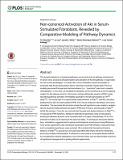| dc.contributor.author | Nim, Tri Hieu | |
| dc.contributor.author | Luo, Le | |
| dc.contributor.author | White, Jacob K. | |
| dc.contributor.author | Clement, Marie-Veronique | |
| dc.contributor.author | Tucker-Kellogg, Lisa | |
| dc.date.accessioned | 2016-01-04T15:50:46Z | |
| dc.date.available | 2016-01-04T15:50:46Z | |
| dc.date.issued | 2015-11 | |
| dc.date.submitted | 2015-04 | |
| dc.identifier.issn | 1553-7358 | |
| dc.identifier.uri | http://hdl.handle.net/1721.1/100579 | |
| dc.description.abstract | The dynamic behaviors of signaling pathways can provide clues to pathway mechanisms. In cancer cells, excessive phosphorylation and activation of the Akt pathway is responsible for cell survival advantages. In normal cells, serum stimulation causes brief peaks of extremely high Akt phosphorylation before reaching a moderate steady-state. Previous modeling assumed this peak and decline behavior (i.e., “overshoot”) was due to receptor internalization. In this work, we modeled the dynamics of the overshoot as a tool for gaining insight into Akt pathway function. We built an ordinary differential equation (ODE) model describing pathway activation immediately upstream of Akt phosphorylation at Thr[superscript 308] (Aktp[superscript 308]). The model was fit to experimental measurements of Aktp[superscript 308], total Akt, and phosphatidylinositol (3,4,5)-trisphosphate (PIP3), from mouse embryonic fibroblasts with serum stimulation. The canonical Akt activation model (the null hypothesis) was unable to recapitulate the observed delay between the peak of PIP3 (at 2 minutes), and the peak of Aktp[superscript 308] (at 30–60 minutes). From this we conclude that the peak and decline behavior of Aktp[superscript 308] is not caused by PIP3 dynamics. Models for alternative hypotheses were constructed by allowing an arbitrary dynamic curve to perturb each of 5 steps of the pathway. All 5 of the alternative models could reproduce the observed delay. To distinguish among the alternatives, simulations suggested which species and timepoints would show strong differences. Time-series experiments with membrane fractionation and PI3K inhibition were performed, and incompatible hypotheses were excluded. We conclude that the peak and decline behavior of Aktp[superscript 308] is caused by a non-canonical effect that retains Akt at the membrane, and not by receptor internalization. Furthermore, we provide a novel spline-based method for simulating the network implications of an unknown effect, and we demonstrate a process of hypothesis management for guiding efficient experiments. | en_US |
| dc.description.sponsorship | Singapore-MIT Alliance (Grant C-382-641-004-091) | en_US |
| dc.language.iso | en_US | |
| dc.publisher | Public Library of Science | en_US |
| dc.relation.isversionof | http://dx.doi.org/10.1371/journal.pcbi.1004505 | en_US |
| dc.rights | Creative Commons Attribution | en_US |
| dc.rights.uri | http://creativecommons.org/licenses/by/4.0/ | en_US |
| dc.source | Public Library of Science | en_US |
| dc.title | Non-canonical Activation of Akt in Serum-Stimulated Fibroblasts, Revealed by Comparative Modeling of Pathway Dynamics | en_US |
| dc.type | Article | en_US |
| dc.identifier.citation | Nim, Tri Hieu, Le Luo, Jacob K. White, Marie-Veronique Clement, and Lisa Tucker-Kellogg. “Non-Canonical Activation of Akt in Serum-Stimulated Fibroblasts, Revealed by Comparative Modeling of Pathway Dynamics.” Edited by Daniel A Beard. PLoS Comput Biol 11, no. 11 (November 10, 2015): e1004505. | en_US |
| dc.contributor.department | Massachusetts Institute of Technology. Department of Electrical Engineering and Computer Science | en_US |
| dc.contributor.mitauthor | White, Jacob K. | en_US |
| dc.relation.journal | PLOS Computational Biology | en_US |
| dc.eprint.version | Final published version | en_US |
| dc.type.uri | http://purl.org/eprint/type/JournalArticle | en_US |
| eprint.status | http://purl.org/eprint/status/PeerReviewed | en_US |
| dspace.orderedauthors | Nim, Tri Hieu; Luo, Le; White, Jacob K.; Clement, Marie-Veronique; Tucker-Kellogg, Lisa | en_US |
| dc.identifier.orcid | https://orcid.org/0000-0003-1080-4005 | |
| mit.license | OPEN_ACCESS_POLICY | en_US |
| mit.metadata.status | Complete | |

